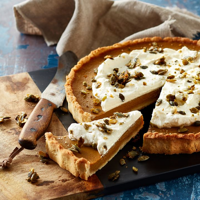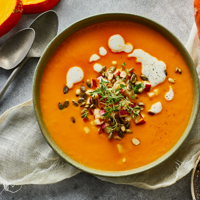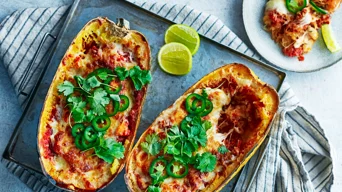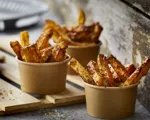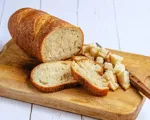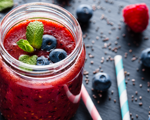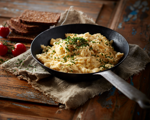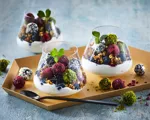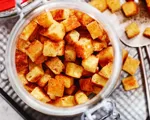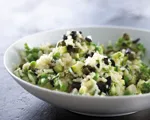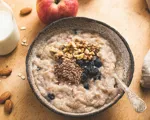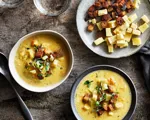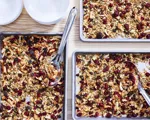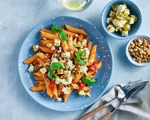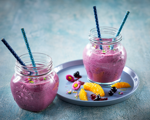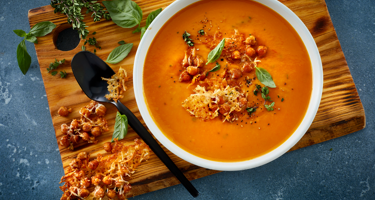
Pumpkins are everywhere once autumn rolls around, but how much do you really know about them? Sure, they are bright orange and perfect for seasonal cooking and festive displays, but there is so much more to them than meets the eye. In this article, you will learn everything there is to know about pumpkins, including what they are, their origins, the main varieties, how to prepare them, and how to store both the flesh and seeds. Let us get right to it!
What is a pumpkin?
A pumpkin is a type of winter squash belonging to the Cucurbita genus in the gourd family and is related to cucumbers, courgettes, and melons. Botanically, it is a pepo, which means it is a berry with a thick rind and edible seeds. Most people picture pumpkins as large, round, and orange, but they actually come in many sizes, shapes, and colours, with varieties ranging from pale yellow to deep green and even striking blue-grey.
Key features:
A firm outer rind that becomes softer when cooked
Vibrant orange or yellow flesh with a mild, sweet, and slightly nutty flavour
Edible seeds
When is pumpkin in season?
Pumpkin is in season from late summer to early autumn, with peak availability from September to November. In the UK and much of Europe, pumpkins remain widely available through October and November, making them a staple for both Halloween and winter cooking.
They thrive in warm weather and are planted in late spring or early summer (May–June in the Northern Hemisphere). Properly stored pumpkins can remain available for several months, which is why they are common in both winter and pumpkin recipes, even though they are an autumn crop.
What is the history of pumpkins?
The history of pumpkins is quite impressive. They were domesticated in Central America, especially in what is now Mexico, between 7,500 and 5,000 BCE. Indigenous peoples of the Americas used pumpkins extensively for food, storage vessels, and ceremonial purposes.
In the 16th century, European explorers brought pumpkins back from the Americas to Europe, and from there they spread into Asia and Africa. Before long, they became part of local cuisines across much of the world. Today, pumpkins are grown globally and are featured in traditional dishes from many different cultures.
Different types of pumpkin
Pumpkins and their relatives come in many shapes, colours, and flavours, each bringing something exciting to the table. From sweet and nutty varieties like red kuri squash to the buttery smoothness of butternut and the fun, stringy texture of spaghetti squash, there is a type to suit every dish. Here is a closer look at some of the most popular pumpkin varieties and what makes each one special.
Red kuri squash (Hokkaido or uchiki kuri)
Red kuri squash, also known as Hokkaido or Uchiki Kuri, is a small, teardrop-shaped variety with bright orange skin. It has a sweet, nutty flavour a bit like chestnuts, and its dense flesh turns soft and creamy when cooked. It is great roasted, blended into soups, or simmered in curries, adding rich flavour to all kinds of dishes. As a bonus, the skin is completely edible, so you can skip the peeling and save yourself some prep time. If you are looking for a delicious way to try this variety, start with our creamy red kuri soup or find more
Butternut squash
Butternut squash is one of the most popular and widely available types of winter squash. With its long pear shape and pale beige skin, it hides bright orange flesh that turns silky and buttery when roasted. The flavour is sweet but mild, so it works well in savoury and slightly sweeter dishes.
Try it in soups, risottos, pastas, casseroles, or simply roasted as a side. Check out our butternut squash risotto, where its natural sweetness pairs perfectly with creamy rice, or browse our collection of the best butternut squash recipes.
Spaghetti squash
Spaghetti squash is an oblong, yellow-skinned squash that transforms into delicate, spaghetti-like strands after roasting, making it a fantastic alternative to traditional pasta. Its flavour is mild and slightly nutty, so it pairs beautifully with bold sauces and toppings. Learn more about the vegetables by checking out our complete guide to spaghetti squash, or try your hand at a
Halloween or field pumpkins
The classic Halloween pumpkin or field pumpkin is the iconic large, round variety often carved into jack-o’-lanterns in October. While its bright orange skin and firm structure make it perfect for decorative purposes, the flesh inside is less sweet and more watery than other varieties, making it less desirable for cooking. However, it is still edible and can be used in soups or purées if prepared carefully.
How to carve pumpkins
Carve pumpkins by cutting off the top around the stem to create a lid, angling your knife slightly inward so the lid does not fall inside when replaced. Scoop out the seeds and stringy pulp using a sturdy spoon until the inside is clean.
Sketch your design on the pumpkin with a pencil or erasable marker. Use a small, serrated knife or pumpkin carving tool to carefully follow the lines. For more detailed designs, try using fine carving tools or cookie cutters with a rubber mallet. Once your pumpkin is carved, place a tea light or LED candle inside for a warm, flickering glow.
An overview of the pumpkin family
The pumpkin world is large and expansive, which is why we have created an overview to help you get to know the varieties better. Understanding their differences helps you choose the right type for your recipes. Here are the most common groups, their characteristics, and how best to use them.
| Botanical Group | Common Names & Examples | Highlights | Taste & Texture | best Uses |
|---|---|---|---|---|
| Cucurbita pepo | Courgette, pattypan (scallopini), spaghetti squash, Halloween pumpkin | Includes summer squashes and carving pumpkins | Mild, slightly sweet; summer types are tender, Halloween pumpkins are watery | Grilling, sautéing (summer squash), pasta substitute (spaghetti squash), decorative pumpkins |
| Cucurbita maxima | Giant pumpkin, red kuri (Hokkaido), buttercup squash | Large winter varieties with dense flesh | Sweet, nutty; smooth and creamy when cooked | Roasting, soups, purées, hearty stews |
| Cucurbita ficifolia | Malabar gourd, fig-leaf gourd | Distinct green-striped skin and fibrous flesh | Mild, slightly sweet; stringy texture | Preserves, jams, traditional Latin/Asian dishes |
| Cucurbita moschata | Butternut squash, butternut pumpkin | Most popular for cooking; long shelf life | Sweet, buttery, and slightly nutty; smooth texture | Soups, risottos, curries, roasting, baking |
How to cook a pumpkin
Cooking pumpkin is easier than many think and offers endless possibilities, from savoury mains to sweet treats. Whether you want the deep, caramelised flavour of roasted wedges, a smooth purée for baking, or a visually stunning stuffed pumpkin, there are several ways to cook pumpkin. Below, we break down the most popular methods.
How to roast a pumpkin
Cut the pumpkin into wedges or cubes, drizzle with oil, and season with salt and pepper. For extra flavour, add spices like cinnamon, paprika, or cumin. Roast at 200 °C for 25–40 minutes, depending on the size of the pieces, until the flesh is tender and the edges are starting to crisp.
Roasting is the easiest way to bring out a pumpkin’s natural sweetness, as the heat caramelises the sugars, giving it a rich flavour and soft, creamy texture with golden edges. If you are new to it, start with our roasted butternut squash recipe.
How to air fry pumpkins
Prepare your pumpkins for air-frying by peeling (if needed) and cutting them into evenly sized cubes or thin wedges. Toss lightly with oil and your preferred seasonings like paprika and garlic powder for a savoury option, or cinnamon and a pinch of cayenne for a sweet-spicy pick. Cook at 180 °C in the air fryer for 15–20 minutes, shaking the basket halfway through to ensure that they brown evenly. For more inspiration, have a look at these
How to boil a pumpkin
Peel the pumpkin, cut it into chunks, and place them in boiling water. Cook for 10–15 minutes, or until tender. Drain well to prevent excess water from making your dish watery. Boiling is a quick, practical way to soften pumpkin, perfect if you are planning to mash or purée it.
How to cut and peel a pumpkin
Cutting and peeling a pumpkin starts with the right preparation. Place the pumpkin on a stable board, slice off the top and bottom to create flat surfaces, and cut it in half from top to bottom using a sharp chef’s knife. Scoop out the seeds and fibres with a spoon, then cut the halves into wedges or cubes as needed.
Whether you peel the pumpkin depends on the variety: red kuri squash has an edible skin that softens during cooking, so you can leave it on, while butternut and field pumpkins benefit from peeling for a smoother texture. To remove the skin, use a sturdy vegetable peeler or a sharp knife, trimming along the natural curve of the flesh. For easier peeling, soften the skin by microwaving the pumpkin for a few minutes first.
How to use a pumpkin in your baking
Use pumpkin in your baking by roasting or steaming the flesh first for maximum flavour, then blend it to a creamy consistency before adding it to the batter. Baking with pumpkin adds moisture and a natural sweetness to desserts, often reducing the need for any additional sugars. Try our recipes for pumpkin pie, pumpkin bread, and
How to make stuffed pumpkin
Smaller pumpkins or squash varieties are perfect for stuffing. Scoop out the seeds and some of the flesh, leaving enough to keep their shape, then fill them with grains, veggies, cheese, or even minced meat. Brush the inside with oil, season well, add your filling, and bake until the flesh is tender and the top is golden. It is an easy way to make a main dish that looks impressive, like our stuffed butternut squash.
How to prepare pumpkin seeds for roasting
To prepare pumpkin seeds for roasting, rinse them thoroughly to remove any pulp after scooping them from the pumpkin. Then, boil in salted water for 5–10 minutes for better seasoning. Drain, dry completely, and toss in oil with spices like cumin, paprika, or cinnamon. Roast at 150–180 °C for 15–25 minutes, stirring occasionally. Let the roasted pumpkin seeds cool before storing them in an airtight container.
How to store a pumpkin
Storing pumpkin correctly ensures it stays fresh for as long as possible, whether you are keeping it whole or have already cut it. Pumpkins are relatively hardy, but like all produce, they need the right environment to prevent spoilage and maintain flavour and texture.
Whole pumpkin
Whole pumpkins keep best in a cool, dark, and well-ventilated space. Aim for a temperature between 10–15 °C, such as a pantry, cellar, or an unheated room. Avoid storing them in areas that are too warm. This will accelerate ripening and decay. Similarly, avoid exposure to frost, which can damage the skin and lead to rot. Do not stack pumpkins on top of each other; instead, place them on cardboard or wooden boards with the stem side down to reduce pressure and improve airflow. When stored properly, whole pumpkins can last anywhere from 3 to 6 months, sometimes longer if they were cured after harvest.
Cut pumpkin
Once a pumpkin is cut, it becomes much more perishable. Wrap the pieces tightly in cling film, beeswax wrap, or store them in an airtight container in the fridge. Use within 3–5 days to enjoy the best taste and texture. For longer storage, pumpkins can be frozen. Peel and cut the flesh into cubes, blanch briefly in boiling water for 2–3 minutes, then cool and freeze in bags or containers for up to 3 months. Alternatively, cook and purée the pumpkin before freezing for easy use in soups, sauces, and baking recipes later.
How long does a pumpkin last?
Pumpkin can last anywhere from a few days to several months, depending on how you store it. Whole pumpkins kept in a cool, dry, well-ventilated spot can last up to 6 months, though smaller varieties like sugar pumpkins might not keep quite as long. Once cut, store the pumpkin in the fridge and use it within 3–5 days. You can also freeze pumpkin cubes or purée for up to 3 months without losing quality. Check stored pumpkins regularly for soft spots or mould, and use those showing early signs of spoilage immediately.

